Accommodation in Japan is getting expensive. Just a few years ago, it was possible to pay next to nothing for a room in a resort. In recent seasons, prices have increased three or four times in some places. Hiring an RV or campervan isn’t cheap, but it’s becoming a more attractive option.
Inspired by Hoshino Resorts’ recent launch of an appealing campervan package, which allows you to enjoy the facilities of their hotels and resorts, I wanted to try something similar in spring on a road trip from Tokyo to Nagano and Hakuba.
Can you actually save money?
The obvious potential saving is for train travel or vehicle hire. The Shinkansen from Narita to Hakuba, for example, costs ¥28,020. For two people, that’s ¥56,040.
Car hire varies significantly depending on when you book, but approximately six months ahead of travel, you can get a mid-sized vehicle for around ¥8,000 per day or a 4WD SUV or people carrier for around ¥10,000 per day from Narita Airport, with a pickup in January or February. For a one-week trip, you’re looking at ¥56,000-70,000, depending on your needs, so the cost of a basic car and getting the train are very similar for a couple.
The other potential saving comes from accommodation. Prices vary, but if we’re comparing against budget hotels, capsule hotels, and places generally outside of the resort but a quick drive away, you’re looking at around ¥7,500 a night for the cheapest options. By my calculations, the cheapest transport and hotels will set you back around ¥16,000 per day for a one-week trip.
Basic campervans start at a similar price point to a standard vehicle at around ¥8,000 per day, but these generally aren’t big enough for a skiing trip. The minimum that I think would be comfortable is the Toyota Grand Hiace available at ¥13,800 per day from Tokyo RV Campers. This is a proper camper van conversion with real beds, a sink, heating and electricity (But no toilet).
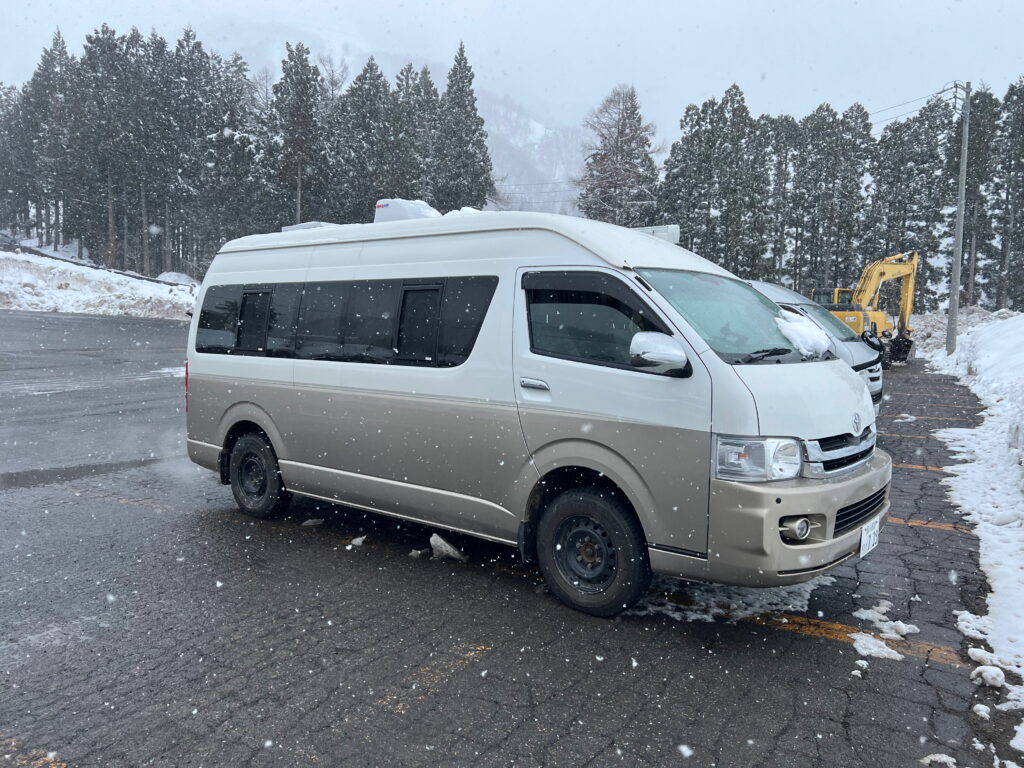
Parked in the spacious RV parking spaces at Hakuba Goryu ski resort.
You also need to factor in that while you can park a campervan for free in some places in Japan, including at some ski resorts, if you want a power hookup, you will need to stay at a campsite, which can eat into your savings. I paid ¥5,500 per night at the RV park in Hakuba. That, plus the RV rental, easily goes beyond the cost of travel and a hotel.
Then you have to consider the inconvenience of travelling in a camper in winter. It’s incredibly cold at night. There’s no toilet. It’s very cramped inside – but you also have the upside of being able to go wherever you want, sleep whenever you want, and potentially be first on the lift each morning.
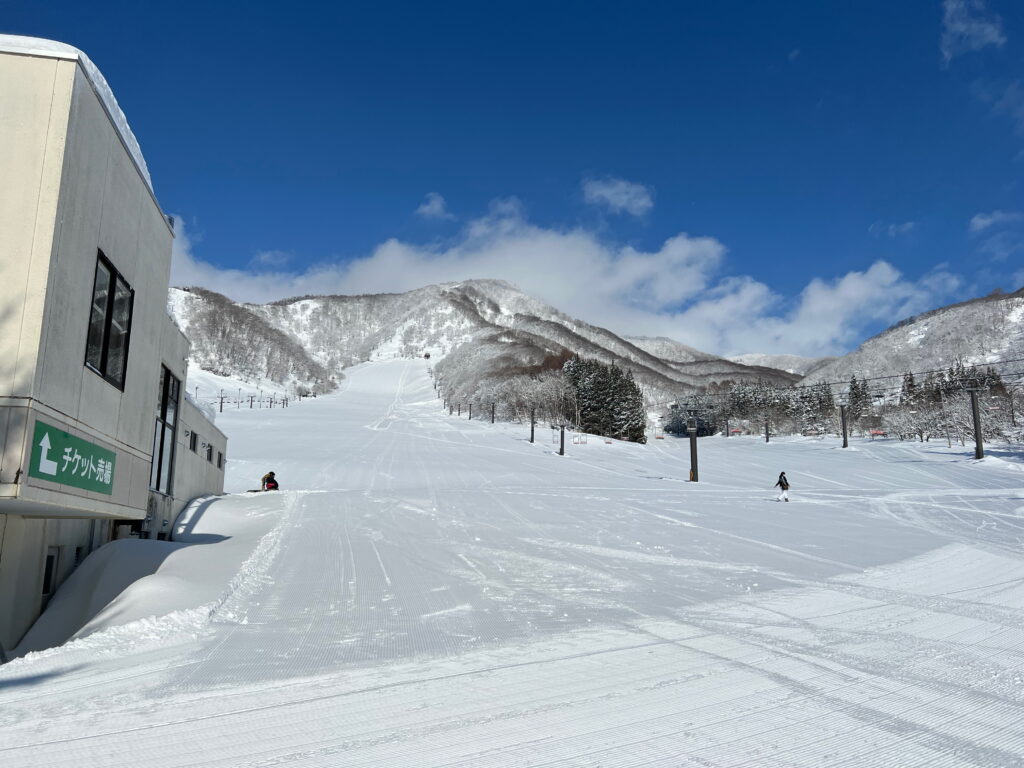
Sunshine and pristine, empty pistes at first lift at Hakuba Norikura Onsen Ski Resort
As a money-saving idea for two people, it doesn’t really add up. However, if you enjoy an adventure, are happy to rough it a bit, and prioritise flexibility and getting to the snow first, it can work. It also means you don’t have to plan so far in advance where you want to go.
If you can live with three or four people in a larger RV, such as a Bongo, then it starts to make sense. Then you can factor in the cost of two hotel rooms (or a larger room), more train tickets, or a bigger vehicle. That could easily add up to ¥25,000 a day versus only a slightly higher outlay of ¥16,800 per day for the bigger RV with space for four to sleep. You have to be really good friends to live in an RV for a week with three other people, though, and finding space for all of your gear will be a big challenge. However, if you’re accustomed to camping or hostels and don’t mind sharing small spaces with others, you can make it work. If it’s the difference between going to Japan and not going to Japan, then you’ve got a huge incentive to make it work.
“There’s no toilet. It’s very cramped inside – but you also have the upside of being able to go wherever you want, sleep whenever you want, and potentially be first on the lift each morning.”
My plan
For my trip, I saw the RV as a safety net. I enjoy moving around, visiting a different resort each day, checking the weather each night, and then making a choice about the next resort. If you’re in a hotel, you can’t really do this with the same efficiency as you can with an RV. You have to keep repacking your gear, checking in and out, and plan in advance to make sure you have a place to sleep (the best ski resorts in Japan sell out of accommodation completely). I wanted to sample free camping, paid campsites, and last-minute hotel bookings, and see which ski resorts allow overnight stays.
A big plus with an RV was that I could make rough plans, then try to book a cheap hotel or campsite each day wherever I happened to be (most of the big hotel booking apps offer discounts for booking on the day of arrival when using their app).
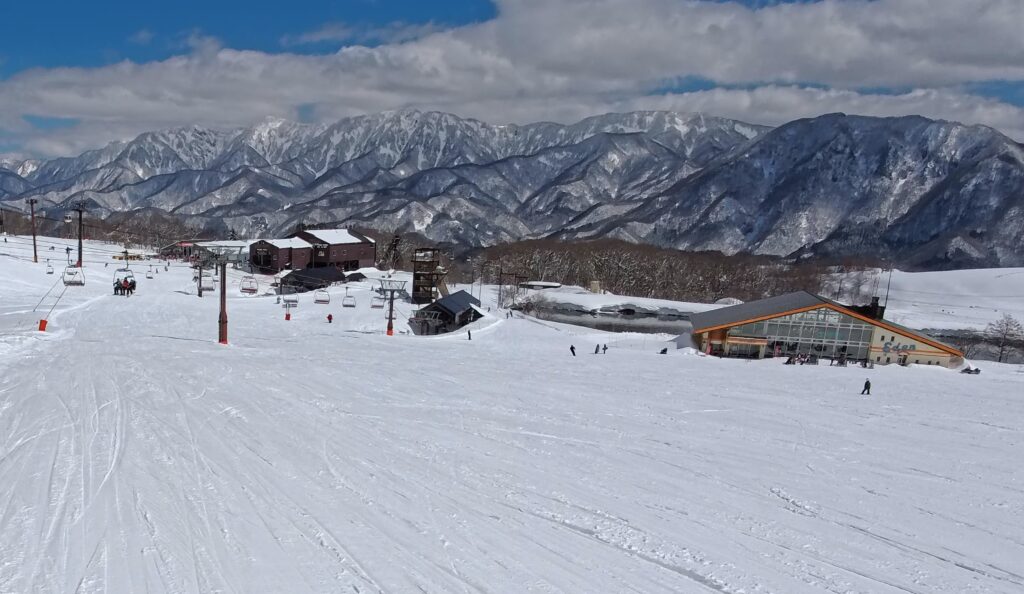
Stunning views and empty slopes at Tsugaike Kogen.
How far should you camp from the resort?
There are three options:
Stay at a free or cheap campsite in the closest city or town that’s at a lower altitude. It will be warmer and cheaper. You get to enjoy the city at night, but you will need to drive for 30-60 minutes in the morning.
Stay at a more expensive campsite in the mountain village, around 15-20 minutes drive from the resort.
Stay at the resort car park.
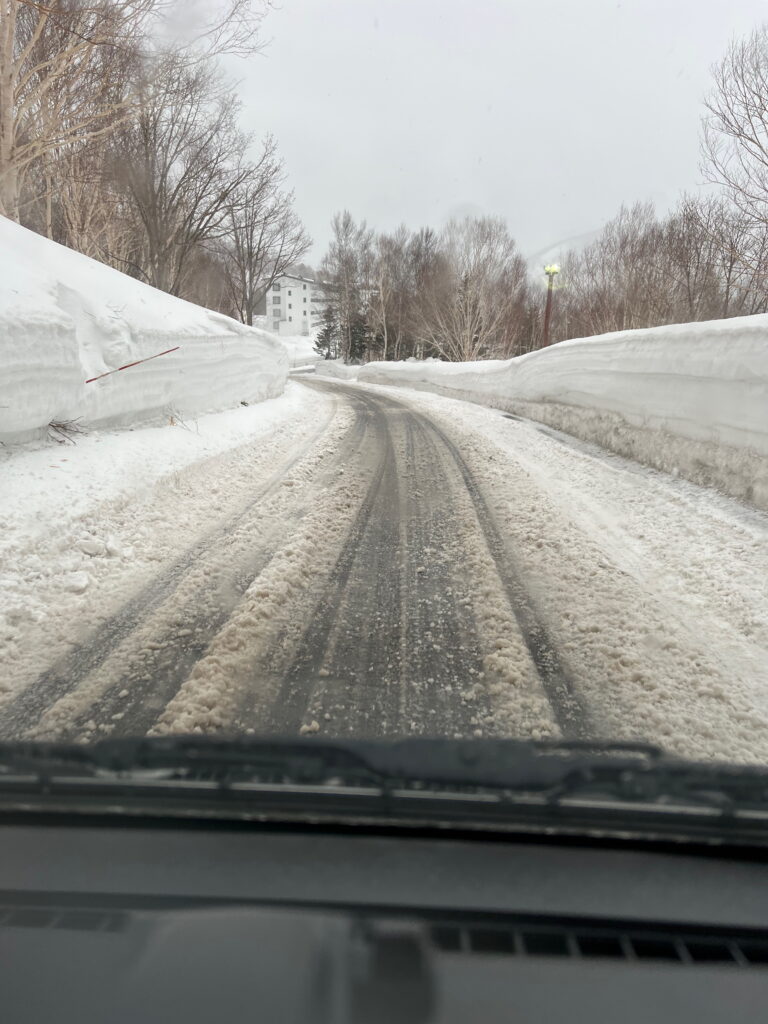
Driving conditions can still be difficult during spring, but the 4WD RV handled it easily.
I mainly followed option two, but option one worked well when I stayed within a 30-minute drive of the Hakuba resorts. I tended to go to sleep early and wake up very early in the camper, so that gave me plenty of time to drive in the morning. Staying somewhere a bit more protected from the weather made a big difference. A good plan is to wake up and then drive straight away. Pick up breakfast at a convenience store, then arrive at the resort early and secure a parking spot near the lift. Then, get ready in the van or the ski resort changing rooms and get the first lift.
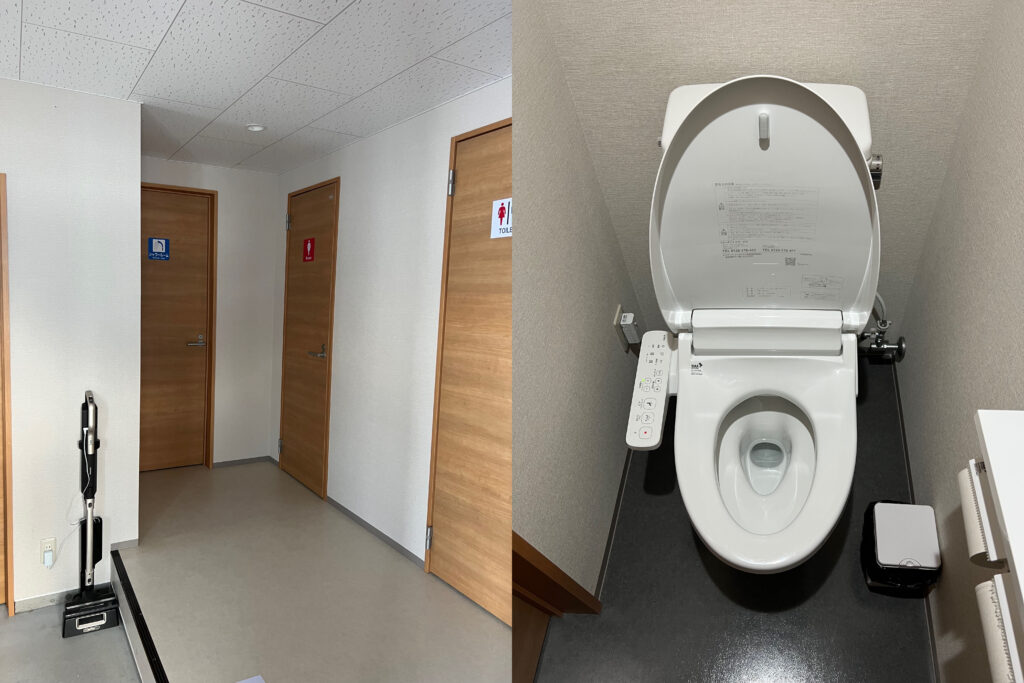
The spotlessly clean showers and toilets at RVパーク白馬 campsite in Happo-One
Staying warm
The camper I used has a built-in heater (imagine a powerful hair dryer). It can’t heat an ice-cold metal van quickly. It takes a good few hours to get the van toasty warm, but it does get there eventually. The novice mistake I made was putting it on full power and going to sleep. I woke up five hours later, sweating and with a dry throat and eyes. I then set it to minimum, fell asleep again, and woke up freezing cold. Try to set the temperature so it doesn’t get too warm. It’s worth turning on the heater for a few hours in the evening after dark to try to find a happy medium, then turning it down just a fraction.
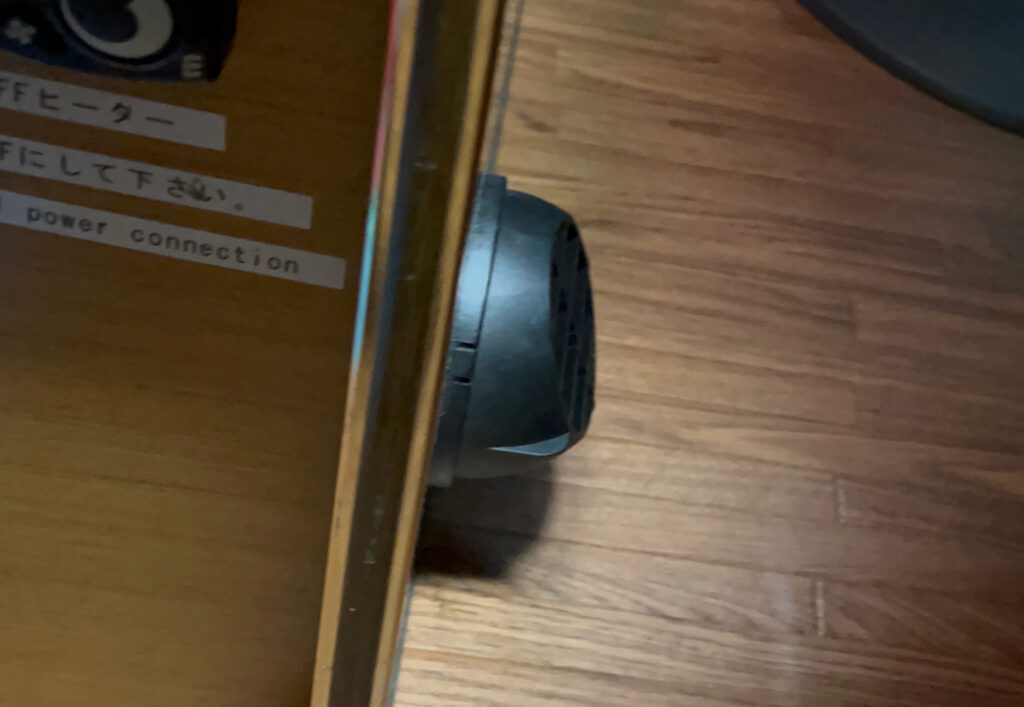
The heater outlet is a small vent under the bottom bunk bed
You want enough heat to protect you from the cold, but you don’t want to cook yourself, as it can be just as unpleasant as being cold. Layers and a good sleeping bag are much better for fine-tuning your temperature. If you wake up, you can easily add or remove a layer, unzip your sleeping bag, or take out your hot water bottle.
I kept boiled water in a two-litre insulated flask, then used a 400ml single-walled metal flask as a hot water bottle that could be refilled when needed. If you’re cooking by fire, baked potatoes or even hot stones wrapped in foil can be put into your sleeping bag for a bit of warmth.
It’s essential to have a sleeping bag that will keep you alive if your heating fails or there’s a sudden blizzard and the temperature drops. A -10 mummy-style bag is a good idea as the hood and drawstring are useful for trapping body heat.
Utilising space
Space is very limited in a camper, especially if you’re sharing. You can’t really spread out your kit or even open your case easily. You have to plan for this and pack your equipment meticulously. I use packing cubes to separate my clothes and items for different purposes. For example, my full clothing for my first day on the hill is in one packing cube, and everything else I need is in my day pack. Then, I don’t have to think about where anything is on the day. Then I hang all my gear above the heater. Once it’s dry, socks and base layers go in the dirty packing cube, and a new set goes out before bed (from the clean packing cube).
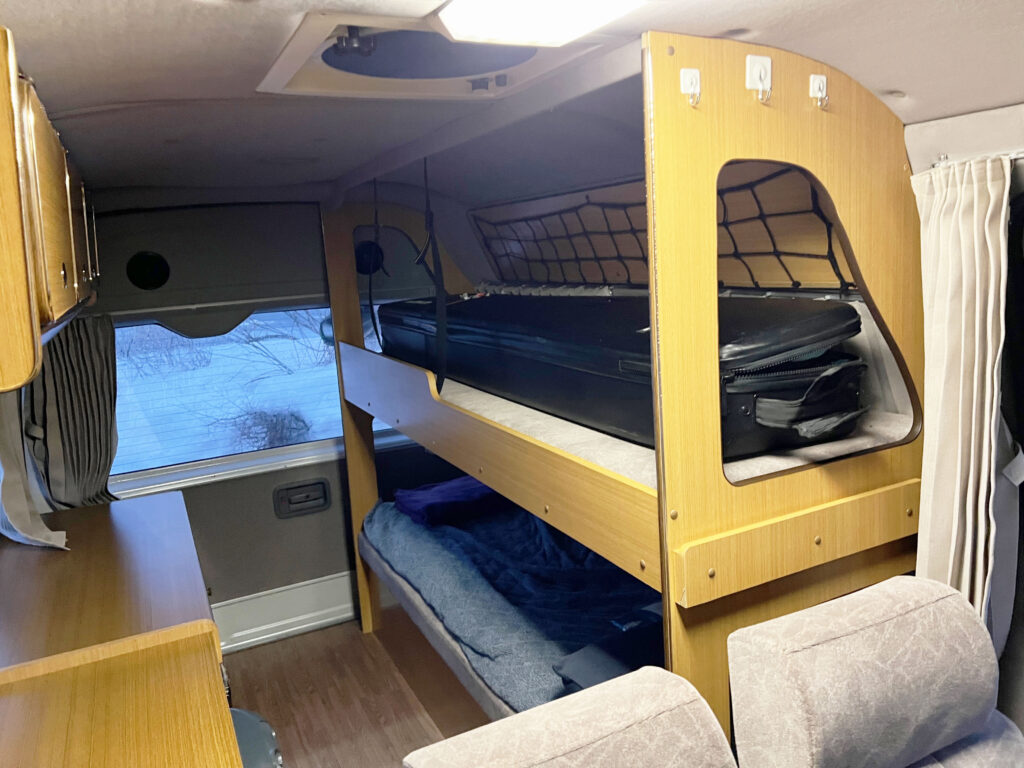
Keeping my snowboard and boots inside my snowboard bag in the top bunk kept things tidy and dry
A solution for wet skis and snowboards is also needed. You don’t want to put dripping wet or icy stuff inside. It’s best to let it dry in a rack somewhere before putting it in the van. Also, be careful that your edges don’t damage the interior. If you’re alone like I was, put your open snowboard/ski bag on the top bunk so you can slip your equipment in.
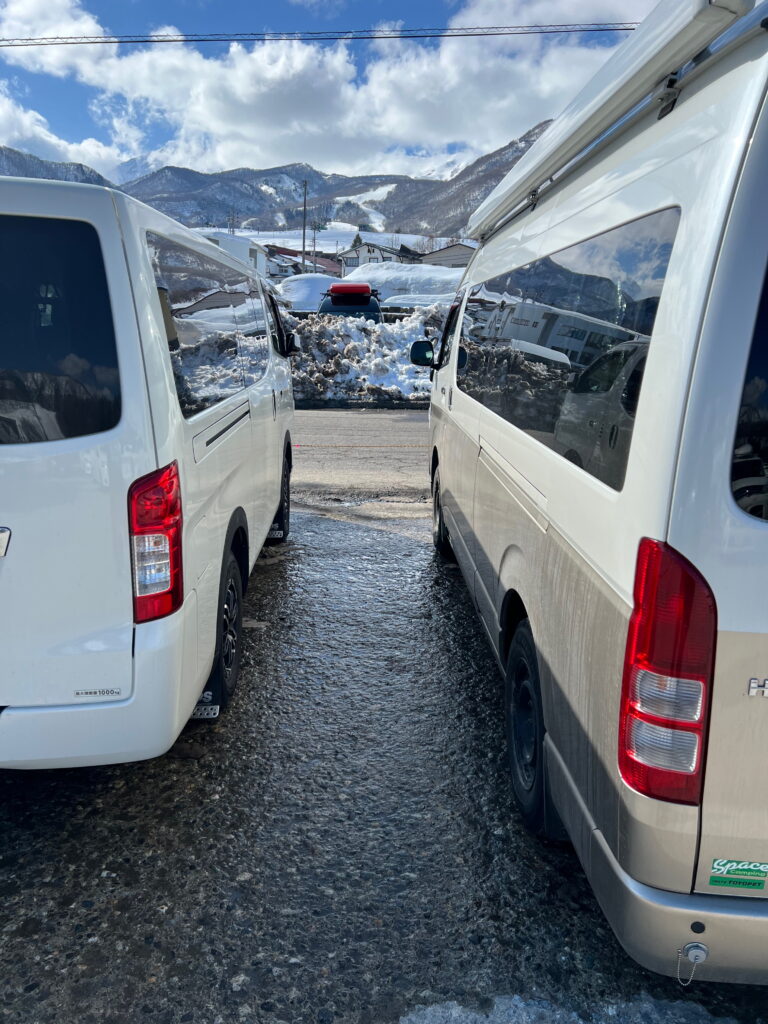
The Grand Cabin Toyota Hiace next to the smaller standard Hiace camper
The Grand Cabin Toyota Hiace is significantly bigger than the standard model. It’s longer, taller, and has a higher ride height. It has a table, bunk beds (that stay permanently in place), a counter with cupboards, a heater, battery power, a hook-up for mains, a fridge, and a sink. There’s no toilet, no shower, and no stove (although a gas stove could be rented).
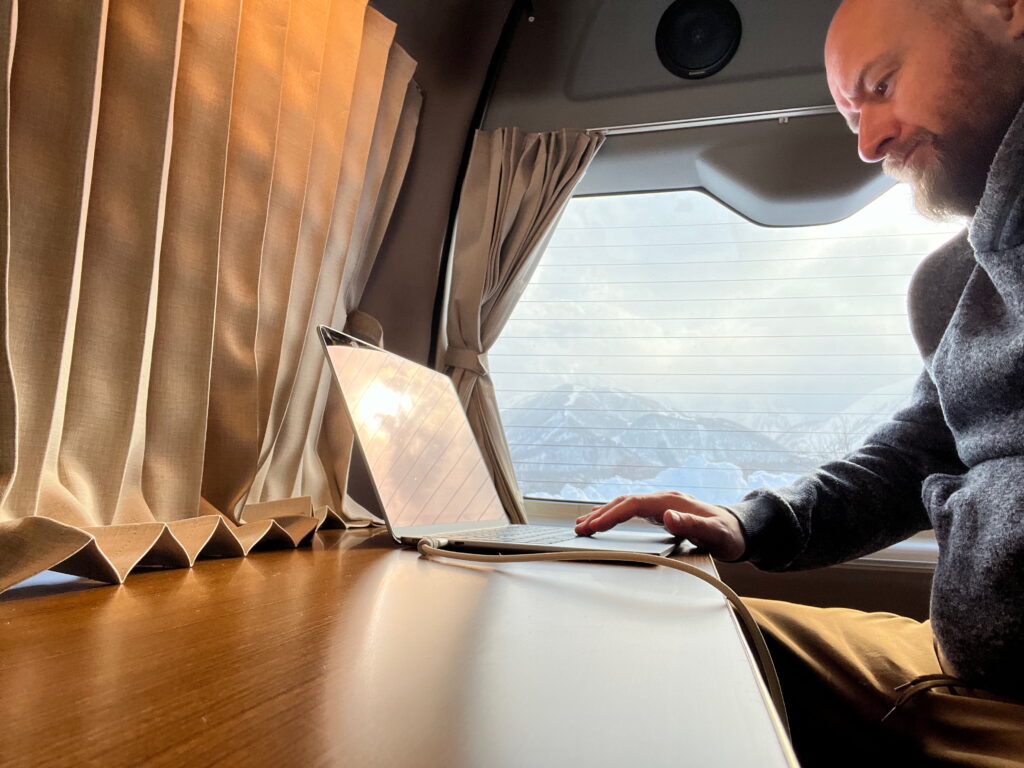
Working at the countertop with Happo-One in the background
One person or a couple are perfect for this vehicle. It would be tricky with a child as well, but doable.
The sleeping experience
If you’re a light sleeper, the heater has a slight hum to it — and you are lying right on top of it. That said, I did fall asleep with it on, no problem (with the help of earplugs). The good thing is, after a day in the mountains, you tend to be exhausted by early evening.
The van did something to me I wasn’t expecting. I was generally in bed and asleep early, and therefore awake early. I’ve never had a ski trip before where I’m up by 6 am every day and at the resort within 30 minutes of the first lift. There’s something to be said for a slightly unpleasant sleeping experience that motivates you to get up. Also, not having a hotel and sometimes being away from bars and restaurants prevents you from overindulging. It forces you to take your skiing very seriously.
Campsite power
Ideally, there would be powered RV campsites near all the ski resorts, and you could just turn up on the day, plug in and stay toasty warm. The reality is, the RV site in Hakuba that’s open in the winter only allows check-in until 5 pm. This means if you’re coming from somewhere that’s a bit of a drive away, it’s tricky to finish your day riding and then drive over and check in. You really want to check in when it’s still light. It wasn’t an issue in the spring, as most days I was done by 2-3 pm because it was getting warm and the snow was becoming heavy. After check-in on the first day, you’re free to come back at any time on subsequent days. I had hoped to do one-night stays and move where the weather takes me.
Parking
Make sure you park flat if you plan to sleep. Getting ready for bed and then lying down to find your bed isn’t flat isn’t fun. You’ll sleep better on a flat surface, so check the bed as soon as you’ve parked.
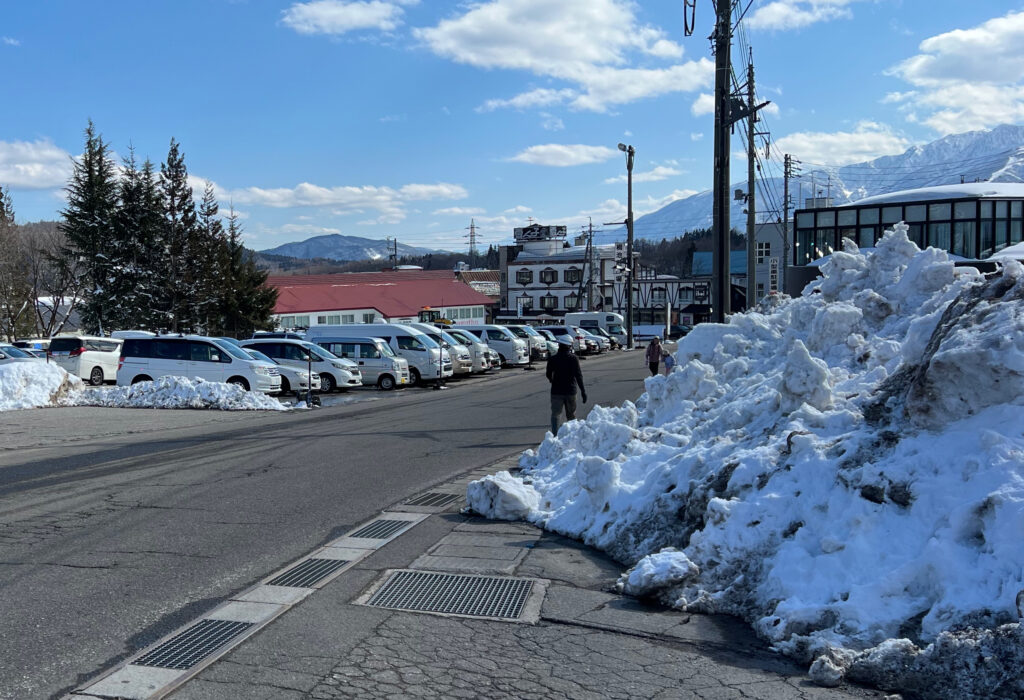
Often ski resorts have reserved priority parking for campervans close to the lift, like here at Tsugaike Kogen
Michi no eki
Michi no Eki are wonderful roadside stations offering good food, souvenirs, clean toilets, and washing facilities, designed to showcase the local area’s delights and delicacies. They aren’t intended for overnight sleeping, but many people still do. It’s more for resting while on the road. They are an institution in Japan, and you’ll see a lot of other campers and truck drivers using them all year round. I used them to sleep in the van twice during the daytime, once after my flight and picking up the camper, and again on my journey back to Tokyo.
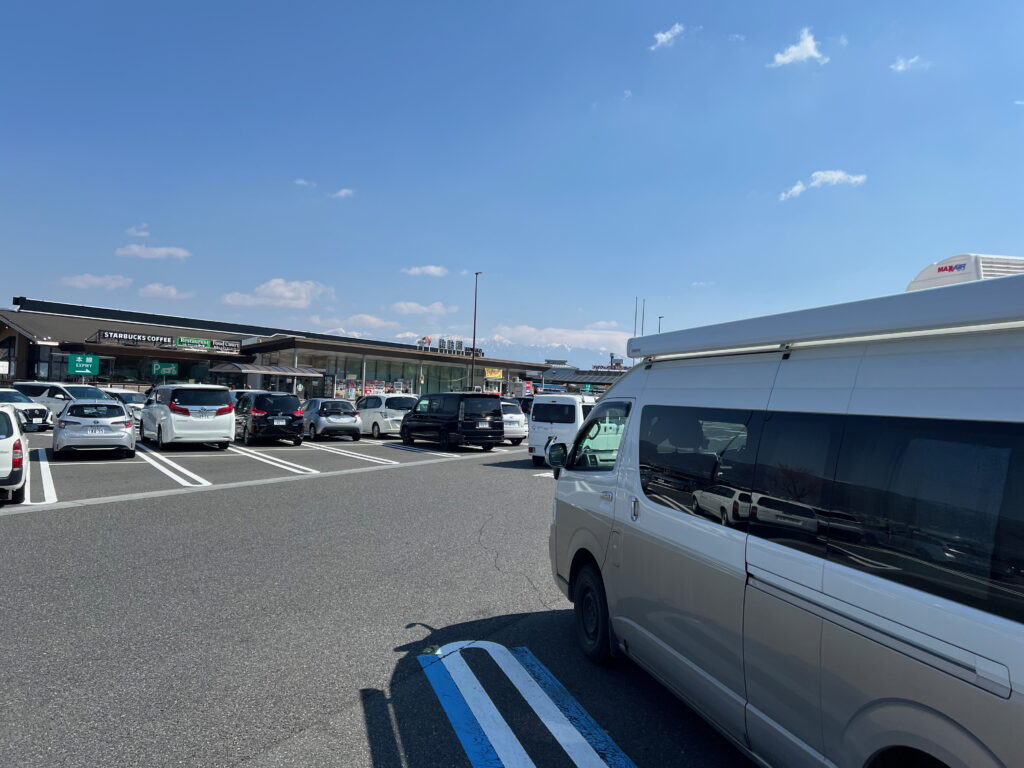
Suwako Service Area by Lake Suwako on the way back to Tokyo.
Onsen
Onsen are a vital part of sleeping in a van. Before bed, take a quick soak in a hot spring, then put on your thermal layers and a hat to retain body heat. Some onsen even allow campers to stay overnight in their car park, but Tokyo RV doesn’t recommend this, as they don’t want you to use the heater without a plug-in power source. Of course, if you don’t intend to use the heater, then it’s fine.
Would I rent a campervan again?
Yes, but I’d do it slightly differently.
Your motivation for getting a campervan for a ski trip might be to save money, or it might be to sleep right next to the ski resort and get in line for the first lift at a different resort every day. Both are possible, but it takes some compromises and some serious dedication.
Camping at ski resorts isn’t possible if you want guaranteed heat and power all night. I think I would embrace the camping side of it more and actually base myself at a lower altitude. You could then use the heater at a lower setting. I’d then drive to the resort at 6 am to beat the traffic and get a prime parking space, then shower, eat, and be ready to go by 8 am.
I would also be tempted to go even later in the season and visit resorts like Gassan that only open in the late spring. On this trip, I planned to maximise on-piste time, but during the trip, I realised that afternoon skiing when it’s sunny isn’t always great. Next time, I would plan to do some other activities in the afternoon. I think Hokkaido would also be a good destination, as there are resorts that stay open later in the season, and you could easily camp in warmer temperatures down low and drive up for some spring skiing. I’d also do more research about resorts and slopes that are protected from the sun. Many of Hakuba’s slopes face the sun (south-facing), so they are sun-affected.
I absolutely loved having a camper. I liked bringing all my kit with me and having the option to return to the van. I enjoyed being able to put on the heater and immediately change my clothes in the van once I was finished. I appreciated the flexibility to adjust my plans and chase the weather. I love the feeling of exploration and freedom that you get when driving an RV, and Japan is the perfect place to do this. The roads are good, traffic is light, drivers are polite, and the scenery is absolutely breathtaking.
ENQUIRE NOW
 Organise your guided backcountry skiing tour in Japan
Organise your guided backcountry skiing tour in Japan
There are lots of options in Hokkaido and Honshu that can be tailored to the kind of skiing you like and when you plan to come. Answer a few questions and we’ll get back to you with some recommendations.
Enquire Now

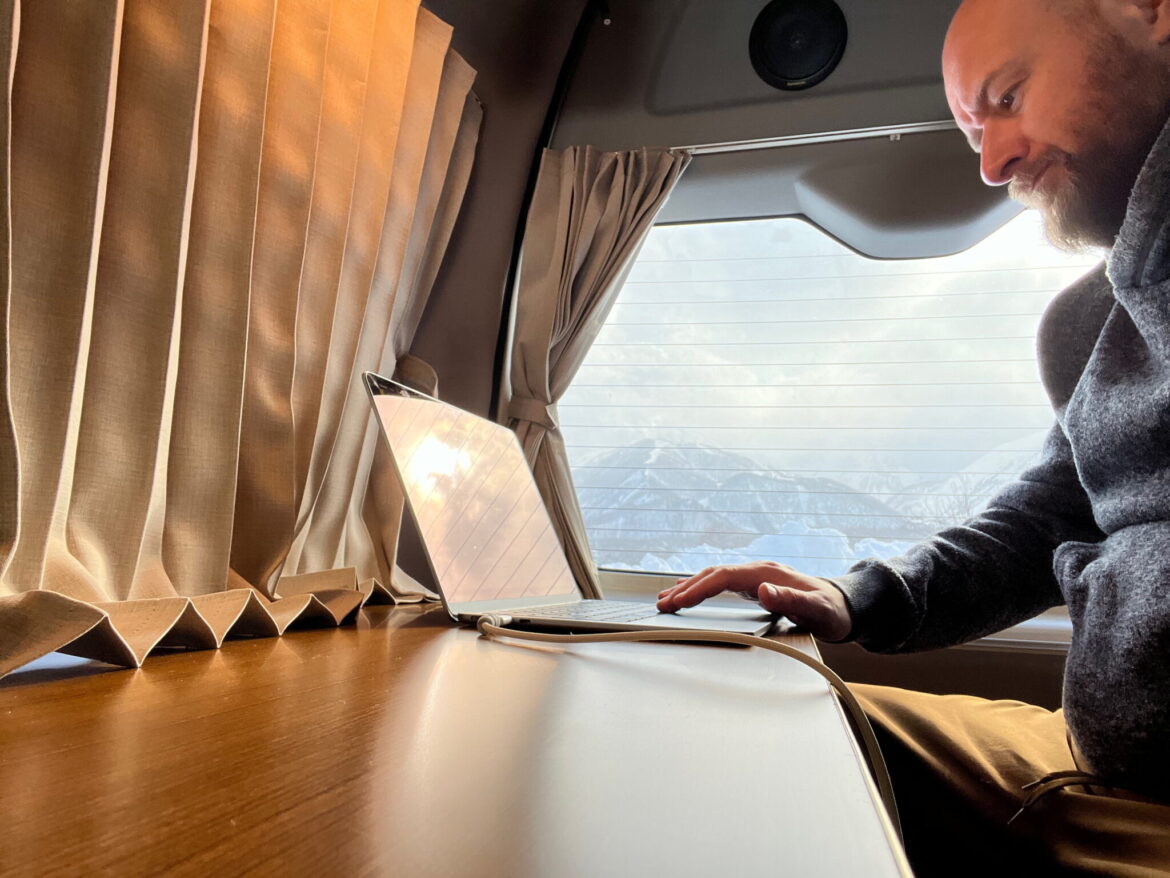
AloJapan.com